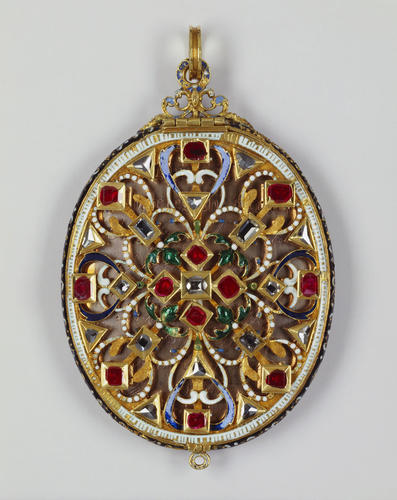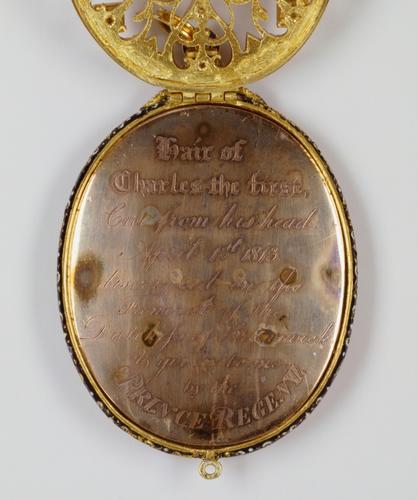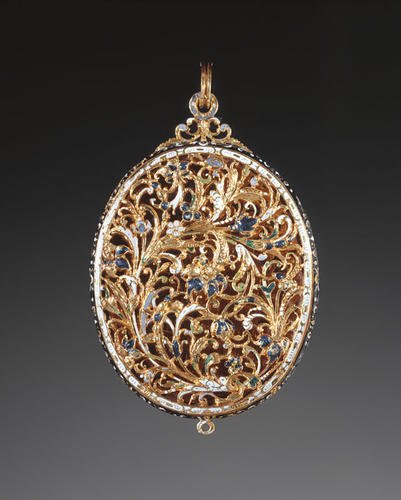-
1 of 253523 objects
Locket containing hair of Charles I c. 1620, with insert 1813
Gold, enamel, Burmese rubies and triangular-cut diamonds | 8.1 x 5.0 x 1.4 cm (whole object) | RCIN 43778

Locket containing hair of Charles I c. 1620, with insert 1813

Locket containing hair of Charles I c. 1620, with insert 1813

Locket containing hair of Charles I c. 1620, with insert 1813



-
Oval gold locket with large scrollwork suspension loop in opaque blue and white enamel, white enamel loop at bottom.
Obverse: openwork pea-pod design in opaque white and translucent dark-blue and green enamel, set with twelve rubies and ten diamonds.
Reverse: pierced asymmetrical floral design in opaque white and various shades of opaque and translucent blue and green enamel. A frieze of rosettes and fleurs-de-lis around the surrounding edge is enamelled in the same colours.
A red-gold case with glass lid containing a lock of hair inside the locket is inscribed: ‘Hair of Charles the First Cut from his head April 1st 1813 Discovered on the Funeral of the Duchess of Brunswick and given to me by the Prince Regent’.
The inner case was made to fit into the locket, probably in 1813. The discovery to which the inscription refers occurred in 1813. During excavations in preparation for the interment of the coffin of George III’s sister Augusta, Duchess of Brunswick (1737-1813), in the royal vault at St George’s Chapel, Windsor Castle, the coffin of Charles I was discovered. The Prince Regent had the coffin opened and the contents examined. His physician, Sir Henry Halford, gave an account of what was found, which included an analysis of the hair.
George IV was fascinated by Charles I, both as King and collector. His fascination was reflected in his conscious attempt to reacquire paintings that had once belonged to the Martyr King.
Although the inscription reads ‘given to me by the Prince Regent’, it does not identify the recipient. Queen Victoria’s inventory of jewels, however, states that the locket had previously belonged to Princess Charlotte (1796-1817), the only child of George IV and granddaughter of Augusta, Duchess of Brunswick. It subsequently passed to her husband, Prince Leopold of Saxe-Coburg-Saalfeld (1790-1865), later King of the Belgians, before entering the collection of Queen Victoria. It was among Queen Victoria’s private belongings taken to Windsor Castle after her death in 1901
Another locket, containing the hair of Charles I, survives among other relics of the King in Carisbrooke Castle Museum on the Isle of Wight. Although it is very different in type and style from this locket, it also once belonged to Queen Victoria before passing to her daughter Princess Henry of Battenberg.
Text adapted from Ancient and Modern Gems and Jewels in the Collection of Her Majesty The Queen, London, 2008Provenance
George IV, when Prince Regent, until 1813. Although the inscription reads ‘given to me by the Prince Regent’, it does not identify the recipient. Queen Victoria’s inventory of jewels, however, states that the locket had previously belonged to Princess Charlotte (1796-1817), the only child of George IV and granddaughter of Augusta, Duchess of Brunswick. It subsequently passed to her husband, Prince Leopold of Saxe-Coburg-Saalfeld (1790-1865), later King of the Belgians, before entering the collection of Queen Victoria some time before 1896. It was among Queen Victoria’s private belongings taken to Windsor Castle after her death in 1901
-
Acquirer(s)
-
Medium and techniques
Gold, enamel, Burmese rubies and triangular-cut diamonds
Measurements
8.1 x 5.0 x 1.4 cm (whole object)
96.9 g (Weight) (whole object)